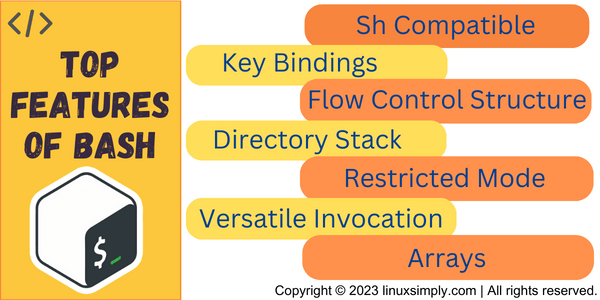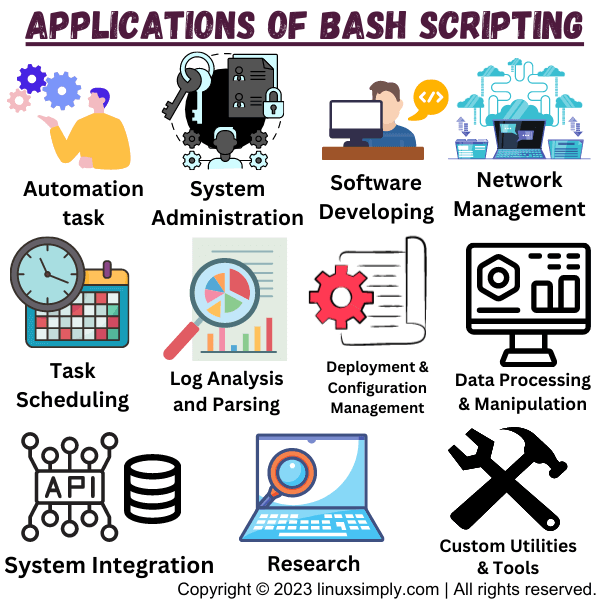FUNDAMENTALS A Complete Guide for Beginners

Bash (Bourne Again SHell) is a versatile and widely used Unix-like command-line interpreter and scripting language. It provides a powerful environment for command execution, task automation, and the creation of complex scripts. In this article, I’ll look at some of the key features of Bash that make it so popular among developers and system administrators.
Key Takeaways
- Knowing the main features of Bash.
- Gathering some insight into Bash’s flow control structure.
- Learning about the versatile invocations and arrays of Bash.
Watch a Comprehensive Review on Features of Bash
Top 7 Features of Bash
In this section, I am going to discuss some of the top features of Bash that make Bash an indispensable companion in the world of command-line computing. Let’s dive in and unlock the power of Bash.
1. Sh-compatible
Bash is derived from the original UNIX Bourne Shell (sh) and maintains compatibility with it. This compatibility ensures that scripts written for the sh shell can run without modification in Bash. Developers can rely on the vast amount of existing sh scripts and port them seamlessly to Bash.
2. Customizable Key Bindings
Bash allows users to customise key bindings, enabling them to define their own key sequences for various editing operations. This feature is particularly useful for power users who prefer specific key combinations for tasks such as command line editing, navigation, and command execution.
3. Flow Control and Conditional Execution
Bash provides flow control mechanisms such as loops and conditionals that enable the execution of commands based on specific conditions. The “if-then-else” construct, along with the logical operators “&&” (AND) and “||” (OR), allows for the conditional execution of commands. Loops, including “for” and “while” enable repetitive execution, iterating over a set of values or as long as a condition is met.
4. Directory Stack
Bash maintains a directory stack, which tracks the recently visited directories. Users can use commands like pushd (add a directory to the stack), popd (remove a directory from the stack), and dirs (display the contents of the stack) to manage the stack efficiently. This feature simplifies navigation between directories and enhances productivity when working with multiple directories.
5. Restricted Mode
Bash includes a restricted mode, activated with the rbash command, bash –restricted, or bash -r. In restricted mode, certain features and commands that could potentially be risky or pose security threats, are disabled or limited. Users use this mode in environments where additional security measures are required.
6. Versatile Invocation
Bash provides flexible invocation options. Users can invoke Bash using single-character options (-a, –b, –c, –i, –l, –r) or multi-character options (–debugger, —help, —login). This versatility allows for fine-grained control over the shell’s behavior and enables users to customise their experience.
7. Arrays
Bash supports one-dimensional arrays, allowing users to store and manipulate collections of data. Arrays provide a convenient way to handle lists of values, iterate over them, and perform operations on individual elements. Arrays in Bash can be indexed using integers or associative arrays with strings as keys.
Additional Features of Bash
As a command-line interpreter and scripting language, Bash also has some other notable features. You can find them below.
1. Command Line Editing
Bash offers a comprehensive set of keyboard shortcuts for efficient command-line editing. Users can easily navigate, edit, and recall commands using a combination of keystrokes. The ability to move the cursor, delete or insert text, search command history, and auto-complete commands greatly enhances productivity and speed.
2. Wildcard Expansion
You can use Wildcard characters such as “*“, “?“, and “[]” for pattern matching and filename expansion. This feature allows users to specify multiple files or directories using concise patterns. For example, “ls *.txt” lists all text files in a guide, and “rm [aeiou]*” deletes all files starting with a vowel.
3. Command Substitution
Bash enables command substitution, which allows the output of a command to be used as an argument for another command. By enclosing a command within “$()” or backticks (“), the output can be captured and utilized in various ways. This feature is handy when dealing with complex pipelines or dynamically generating arguments.
4. Variables and Parameter Expansion
Bash supports variables, which are placeholders for storing data. The variable expansion enables the use of variables within commands or scripts. Furthermore, parameter expansion allows for manipulating and transforming variables by adding prefixes, suffixes, or performing string replacements. This flexibility facilitates dynamic scripting and enhances code reusability.
5. Job Control
Bash supports job control, allowing users to manage and control multiple processes running in the shell. You can use built-in commands to achieve Background execution, suspension, resumption, and termination of processes. Moreover, this feature is particularly valuable when running long-running or resource-intensive tasks.
6. Input/Output Redirection
Bash provides powerful input/output redirection capabilities. You can redirect Standard input (stdin), output (stdout), and error (stderr) streams to files or other processes using symbols like “>“, “>>“, “<“, and “2>“. This functionality enables users to manipulate and process data from various sources and direct output to different destinations.
7. Scripting Capabilities
Bash is a versatile scripting language, offering the ability to write complex scripts for automating tasks, system administration, and more. With control structures, variables, functions, and file manipulation operations, you can create Bash scripts to handle a wide range of tasks. Additionally, extensive support from the Linux ecosystem and vast online resources make it easy to find solutions and share code snippets.
Practical Applications of Bash Scripting
Bash scripts are incredibly adaptable and useful for a variety of tasks. The following are some real-life applications for Bash scripting:
- Automation task: You can automate recurring tasks and processes using bash scripting. By doing this, users can save time while lowering the possibility of manual error.
- System Administration: Bash scripting can be used to troubleshoot systems by inspecting system configurations and network connections. In order to update and configure systems, monitor running systems, and distribute software patches and updates, administrators rely on the Bash script.
- Software Developing: To compile code, debug source code, manage changes, test software, and perform other tasks, software developers use Bash scripting.
- Network Management: In particular on corporate networks, network engineers often use bash scripting to configure and optimise network performance.
- Task Scheduling: Commands like cron can be used to schedule the execution of bash scripts. This enables you to automate routine tasks like creating reports or running system backups that need to be done on a regular basis.
- Log Analysis and Parsing: Bash scripting provides powerful tools for parsing and analysing log files. Scripts can extract relevant information, generate reports, and alert administrators about specific events or errors.
- Deployment and Configuration Management: Bash scripting is often employed in deployment and configuration management workflows. Scripts can automate software installations, configuration updates, and system setup on multiple machines, ensuring consistency and reproducibility.
- Data Processing and Manipulation: Bash scripts are handy for processing and manipulating data, such as parsing CSV files, extracting information from structured text, performing calculations, and generating reports.
- System Integration: Bash scripts can facilitate system integration by providing a means to interact with external tools, APIs, and databases. They can be used to automate data transfers, synchronize systems, and perform data transformations.
- Custom Utilities and Tools: Bash scripting allows users to create custom utilities and tools tailored to their specific needs. These scripts can automate personal workflows, simplify complex tasks, and extend the functionality of Bash.
- Research Purpose: Computer scientists use Bash for research purposes, such as managing research systems and conducting research on those systems.
These are just a few examples of the wide range of applications for Bash programming. Its versatility and extensive support in the Linux and Unix environments make it a popular choice for scripting and automation tasks.
Conclusion
Bash is a robust and feature-rich shell and scripting language that offers a wide range of powerful tools to developers and system administrators. Its capabilities for command-line editing, wildcard expansion, command substitution, variables, flow control, job control, input/output redirection, and scripting make it an indispensable tool for efficient and flexible command-line interaction and automation. Bash’s extensive feature set enables you to be more productive and easily complete complex tasks, whether you’re a beginner or an experienced user.
People Also Ask
Related Articles
- What is Bash Scripting? [A Quick Overview]
- Is Bash a Programming Language? [Quick Analysis]
- Bash vs Zsh [The Ultimate Comparison]
- Bash vs PowerShell [Quick Comparison Guide]
<< Go Back to Introduction to Bash Scripting | Bash Scripting Tutorial





